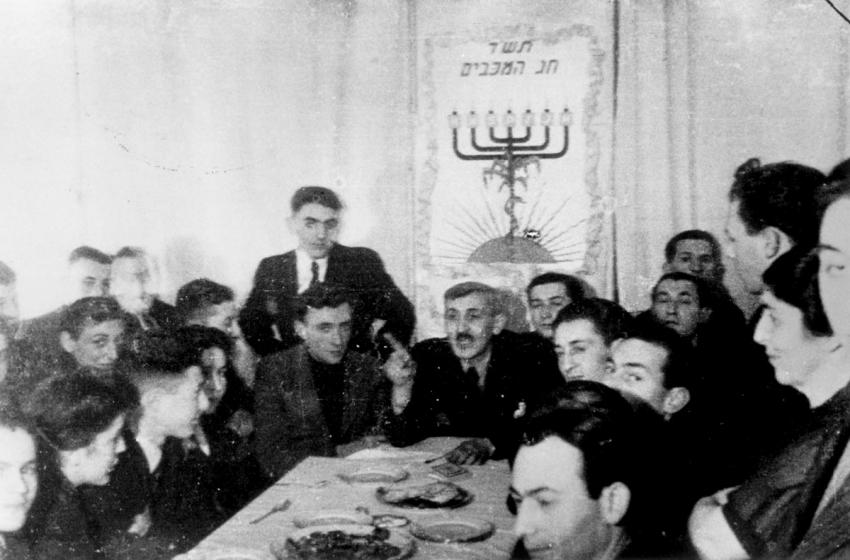On the eve of World War II, Lodz, Poland was home to some 165,000 Jews. In September 1939, the Germans occupied Lodz, and established a ghetto in the city in February 1940. In the first half of 1942, 55,000 Jews were deported to the Chelmno extermination camp and murdered. Factories were built in the ghetto, where the surviving Jews were put to work.
In December 1943, the eve of Hanukkah, Oskar Singer, a German Jew who had been deported to the Lodz ghetto wrote:
In the ghetto, Hanukkah is a family holiday, as it was before the war… It doesn't require any formal setting. The Jew who wants to respect the memory of the Maccabees in the traditional way observes the festival in his own home.
In the street, by a broken door, on filthy stairs, a figure sits wrapped in rags. This figure offers candles… usually these are Sabbath candles, sold each week on Sabbath eve. This time… they are candles for the Hanukkah menorah.
Not everyone can afford to give the menorah its full radiance. The menorah's eight branches means – when one lights an extra candle each day – 36 candles, and with the "Shamash" – 37 candles. So, if we express this monetarily, at least 18 marks, if we calculate each candle as costing 50 pfennigs. But some famiilies can afford to buy candles for one mark, so the "lighting" alone costs them 36 marks.
Nevertheless, despite the hardships of this place and the lack of funds, this year too we will celebrate Hanukkah with dignity.
Many, many families light candles. As with holy books, prayer books, prayer shawls and phylacteries, the head of the family…. smuggles the Hanukkah menorah from the city [to the ghetto]. You can see simple menorahs made of brass or iron, but also those made of copper and nickel, menorahs old and new, made industrially and by hand, free-standing menorahs, and wall menorahs. Friends and acquaintances are invited. In dark stairwells, through courtyards and damp hallways, they climb up to the apartment, usually comprising just one room, used both as the living and celebratory space.
Many wear festive clothes… One of the people gets a special honor. Usually it's the daughter of the house, and she sings the candle-lighting blessing. Often it happens that Jews brought here from the surrounding areas and German Jews from the west meet in this room and celebrate the holiday together. The candles shine brightly, and memories of past Hanukkah evenings float to the surface. Memories from youth, from student years, memories of years lived in joy and freedom, scenes and pictures connected in some way to the festival of the Maccabees.
People meet "privately", with no formal ritual, just the menorah candles burning. Children also celebrate Hanukkah. In the larger apartments, many people gather. Everyone brings a small, fitting gift: a toy of some kind, a slice of cake, a hair ribbon, some empty cigarette packets in many colors, a plate decorated with flowers, a pair of socks, a warm hat. There is a lottery, and it's all a matter of luck.
After candle-lighting, gifts are exchanged. Ghetto gifts are not monetarily valuable, but they are received with profound gratitude. Eventually, songs are sung in Yiddish, Hebrew and Polish. In each case, songs that are supposed to lift the spirits. A few hours of festivity, a few hours to forget, a few hours to let the mind wander… Would that Hanukkah 1943 would be the last in wartime, the last Hanukkah in the ghetto. That is everyone's hope. People share this wish with friends when parting – wordlessly, mutely, with a squeeze of the hand.
The menorah candles go out, darkness prevails once more. We go out into the street. Ghetto life starts again.
Eight months later, in the summer of 1944, the Nazis deported the rest of the Jews in the Lodz ghetto to the Chelmno and Auschwitz extermination camps.
This photograph is part of a collection taken by Mendel Grosman and his assistant, Arie Ben Menachem (Princ) in the Lodz ghetto.







